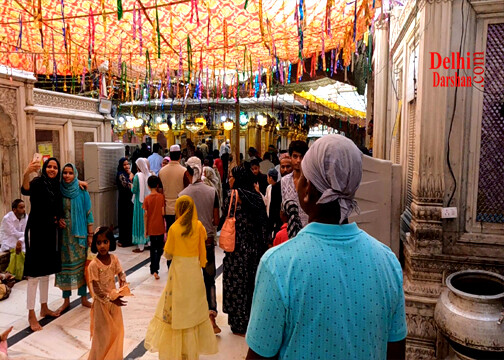Delhi, the heart of India, is a city where the past seamlessly blends with the present. Its history is a tapestry woven with the threads of countless empires, and one of the most vibrant and intriguing chapters in this narrative is the Mughal Era. To explore the grandeur and legacy of this period, there’s no better way than the “Delhi’s Mughal Era Tour” offered exclusively by Delhi Darshan. Kindly WhatsApp us, for Mughal Era at Delhi.
Stepping into History
The Mughal Era Tour is a mesmerizing journey that invites you to step into the past, where emperors reigned, art flourished, and the city’s architecture was transformed into a masterpiece of grandeur. It’s an immersive exploration of the Mughal dynasty’s rich heritage and their indelible mark on Delhi’s landscape.
Why Choose Delhi Darshan
Booking the Mughal Era Tour through Delhi Darshan offers a multitude of advantages that elevate your experience to a whole new level:
Expert Guided Tours
Our tours are led by expert guides who are passionate about history and well-versed in the nuances of the Mughal Era. They bring historical narratives to life, ensuring you gain a deeper understanding of the past.
Hassle-Free Planning
Delhi Darshan takes care of all the logistics, from transportation to entry tickets. You can relax and immerse yourself in history and culture without the burden of planning.
Exclusive Access
We offer access to some of the most iconic Mughal-era landmarks and hidden gems that are not easily accessible to the general public.
Tour Highlights
The Mughal Era Tour is a captivating exploration of the following key sites and experiences:
Humayun’s Tomb
Begin your journey at Humayun’s Tomb, a UNESCO World Heritage site that set the architectural precedent for the Taj Mahal. Built in the 16th century, Humayun’s Tomb is one of the most significant Mughal-era monuments in Delhi. It is an exemplary piece of Mughal architecture and served as an inspiration for the Taj Mahal. The tomb complex includes beautiful gardens and several other tombs of Mughal nobles.
Qutub Minar
Explore the towering Qutub Minar and the surrounding complex, a testament to the Mughals’ architectural prowess. Although not directly from the Mughal era, Qutub Minar complex includes structures from both the Mughal and pre-Mughal periods. The Qutub Minar itself is a towering minaret built by Qutub-ud-din Aibak in the 12th century. It is a UNESCO World Heritage Site and showcases a fusion of Indo-Islamic architecture.
Red Fort
Marvel at the iconic Red Fort, a symbol of Mughal power, and wander through its magnificent architecture. The Red Fort was the main residence of Mughal emperors in Delhi. Built in the 17th century, it showcases a blend of Persian, Islamic, and Indian architectural styles. The fort complex features magnificent palaces, audience halls, museums, and beautiful gardens.
Jama Masjid
Visit the grand Jama Masjid, one of the largest mosques in India, showcasing Mughal architecture at its finest.
A Walk in the Bazaars
Immerse yourself in the bustling streets of Old Delhi, where you can savor the flavors of Mughal cuisine and shop for souvenirs. Located opposite the Red Fort, Jama Masjid is one of the largest mosques in India. It was built by Mughal Emperor Shah Jahan in the 17th century. Jama Masjid exhibits splendid Mughal architecture, with its imposing red sandstone structure, minarets, and a vast courtyard capable of accommodating thousands of worshipers.
Safdarjung Tomb
Constructed in the 18th century, Safdarjung Tomb is the mausoleum of Nawab Safdarjung, a powerful statesman during the Mughal era. The tomb complex features stunning Mughal architecture, beautiful gardens, and intricate artwork.
Shalimar Bagh
Shalimar Bagh, located in the north of Delhi, was built during the reign of Emperor Shah Jahan. It is a beautiful Mughal-style garden adorned with fountains, pavilions, and water channels.
Zafar Mahal
Situated near Mehrauli, Zafar Mahal was built by Bahadur Shah II, the last Mughal emperor. It served as his palace and is known for its distinct architectural style and intricate carvings.
Hazrat Nizamuddin Dargah
The Nizamuddin Dargah is the mausoleum of the famous Sufi saint Hazrat Nizamuddin Auliya. It was constructed during the Mughal period and showcases Mughal-style architecture. The site is also home to several other historical tombs and structures.
Hauz Khas Fort
Hauz Khas Fort, located in the Hauz Khas Village, dates back to the 14th century during the reign of Alauddin Khilji. It features remnants of Mughal-era architecture, including the imposing fort walls and a beautiful reservoir.
Zinat-ul-Masjid
Also known as Ghata Masjid, Zinat-ul-Masjid was built by Zinat Asiya, one of the wives of Mughal Emperor Aurangzeb. It is a small mosque known for its intricate design and architectural beauty.
Sher Mandal
Located within the Purana Qila complex, Sher Mandal is a two-storeyed octagonal structure. It was initially constructed as a pleasure pavilion by Emperor Sher Shah Suri but later served as the library and observatory of Emperor Humayun.
Nila Gumbad
Nila Gumbad, meaning “Blue Dome,” is a beautiful Mughal-style tomb located in the Nizamuddin East area of Delhi. It is believed to be the tomb of a noble from the Mughal court and is known for its blue-colored dome and intricate tile work.
Khairul Manzil Masjid
This mosque, also known as Lal Gumbad Mosque, is located near Nizamuddin East. It features a striking red dome and beautiful architectural elements reminiscent of Mughal design.
Bijri Khan’s Tomb
Situated near Humayun’s Tomb, Bijri Khan’s Tomb is an ornate Mughal-era mausoleum. It is known for its intricate carvings, beautiful marble work, and intricate lattice screens.
Sher Shah Suri Gate
Located in the vicinity of Old Fort, this gate was built by Sher Shah Suri, the Afghan ruler who briefly interrupted Mughal rule in Delhi. It serves as a reminder of the Mughal dynasty’s encounters with other powerful rulers of the time.
Barakhamba
Barakhamba, meaning “Twelve Pillars,” is an impressive Mughal-era monument located in the vicinity of Connaught Place. It was once part of a larger complex and is known for its twelve-sided structure and intricate architectural details.
Begumpuri Masjid
This mosque, situated in the Malviya Nagar area of Delhi, was built during the reign of the Tughlaq dynasty but showcases Mughal architectural influences. It features a large prayer hall and beautiful minarets.
Bijay Mandal
Bijay Mandal, located near Malviya Nagar, is a historical tower built during the Tughlaq dynasty. It later served as a hunting lodge for the Mughal emperors and offers panoramic views of Delhi from its top.
Azim Khan’s Tomb
Azim Khan’s Tomb is a Mughal-era tomb located near the Qutub Minar complex. It is known for its unique architectural style and intricate ornamentation.
Isa Khan’s Tomb
Located within the Humayun’s Tomb complex, Isa Khan’s Tomb is a beautiful octagonal tomb dedicated to Isa Khan Niazi, an Afghan noble during the reign of Sher Shah Suri. It features exquisite carvings and intricate detailing.
Chor Minar
Chor Minar, meaning “Tower of Thieves,” is an intriguing Mughal-era structure located in the Hauz Khas area of Delhi. It is believed to have been used as a warning to deter thieves and features 225 small holes where severed heads of criminals were displayed.
Shahi Hammam
Situated near the Red Fort, Shahi Hammam is a historical Mughal-era bathhouse. It was used by the Mughal royalty for bathing and relaxation and showcases impressive architecture and intricate tile work.
Hastsal Minar
Hastsal Minar is a lesser-known Mughal-era monument located in Uttam Nagar, West Delhi. It is a tall minaret with an octagonal base and showcases fine craftsmanship and architectural elements of the Mughal period.
Shah Alam’s Tomb
Shah Alam’s Tomb is the final resting place of Mughal Emperor Shah Alam II, who reigned during the late 18th century. The tomb is located in the Shahdara area of Delhi and features impressive Mughal architectural elements.
A Journey of Discovery
The Mughal Era Tour is not just about visiting historical landmarks; it’s about stepping into an era of artistic brilliance, architectural marvels, and the Mughals’ cultural influence. It’s a journey of discovery that offers a profound appreciation for the past.
Book Your Tour Today
Don’t miss the opportunity to embark on this captivating journey through India’s Mughal heritage. The Mughal Era Tour, exclusively offered by Delhi Darshan, is your gateway to a glorious bygone era. Book your tour now, and let us transport you to a time when emperors ruled, art flourished, and Delhi was the epicenter of culture.
Visit DelhiDarshan.com or call us at 7042661212 to book your Mughal Era Tour today. History is calling, and Delhi Darshan is your trusted guide to answering that call.
Delhi’s Mughal Era Tour: A Journey Through Time with Delhi Darshan
Other Options:
You may opt for Delhi VIP Tours or Delhi Darshan Cab Booking as well. WhatsApp us, for Mughal Era at Delhi.
The above-mentioned information may change from time to time. If you find any change in details, then kindly contribute with the latest information. Delhi Darshan has created this page for general information. So, that visitors to the city can get maximum output from their trip.
.
This post was last modified on 4 April, 2024 4:11 pm

